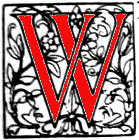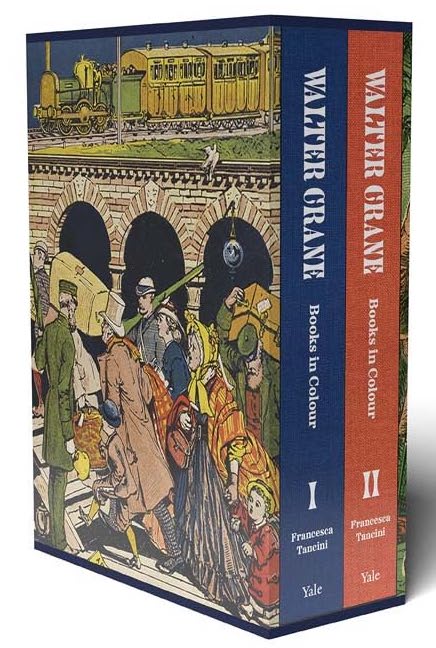
alter Crane was one of the most productive, versatile, and influential artists of his time. His work included children’s books – for which he is most remembered – ‘yellowbacks,’ novels of all sorts, and even publications for hobbyists. But his status as a popular illustrator for the nursery and fireside was only part of his achievement; he was also a painter and writer on art, an advocate for the Arts and Crafts movement, a socialist under the spell of William Morris and a designer of ceramic tiles, wallpaper, book covers and bookmarks. Endlessly creative and experimental, eclectic in his borrowing from Morris’s notions of art and functionality, Pre-Raphaelitism, Aestheticism and Classicism, Crane is a difficult figure to define in a few words. As John Russell Tayor remarks, he is altogether ‘too big and unmanageable … to be fitted neatly into any single pigeon-hole’ (64).
The vast complexity of his output in so many fields has probably worked to discourage scholars from the task of mapping his achievements. Contrasted with Dante Rossetti, for instance, whose creative output has been extensively analysed, Crane has rarely been the subject of extended modern commentary. Most attention has been directed at his illustrations, notably in studies by Rodney Engen (1975) and Isobel Spencer (1975), but both of these are general discussions and were limited, at the time of writing, by key information that has since been released. Clearly, what is needed is an expansion of scholarship in which Crane’s books are examined in detail.

Francesca Tancini takes a huge step forward in her monumental two volume study, Walter Crane: Books in Colour. Tancini sets out to provide detailed bibliographical and contextual information: as she explains, her objective is to provide ‘a new catalogue, addressed to scholars, historians, collectors, book dealers and enthusiasts of visual matter and Victoriana’ (1, 13.) To that end she presents a listing of Crane’s books along with historical accounts of the circumstances in which they were produced, the artist’s relationships with publishers and engravers such as Edmund Evans, and the ways in which the publications could be contextualized within the culture of their time. Tancini’s research is meticulous and exhaustive, drawing together a huge body of material from around the world. In so doing she greatly expands the artist’s bibliography, presenting what is probably a definitive list. Writing in 1923, Gertrude Massé came up with 170 titles; Tancini finds 450, 274 of which are identified, and described, for the first time. Each of these is illustrated by a high-quality photograph.
The author opens the first volume with an informative introduction and organizes the catalogue into three main groups – ‘Illustrated Books,’ ‘Toy Books’ and ‘Yellowbacks.’ The first two of these feature in volume 1 and in each case Tancini considers the works by publisher rather than date – with detailed sections on the books issued by Routledge, Nimmo, Marcus Ward, and others. Volume two follows the same format though here the focus is on yellowbacks – the cheap editions that were sold at railway kiosks and newsagents and reached out to a huge market of readers as literacy improved. Again, Tancini’s study is all-embracing as she presents sections on books published by all of the main Victorian houses – among them Chapman and Hall, Smith, Elder, Maxwell and Richard Bentley – as well as including lesser-known publishers that have slipped from view.
Walter Crane: Books in Colour is, in short, an outstanding piece of scholarship. Not only a comprehensive catalogue, it includes numerous insightful commentaries. The focus is generally on publishing contexts, but Tancini makes many other telling remarks. Speaking of yellowbacks, she notes that Crane’s vivid cover illustrations are ‘witnesses of bygone times’ and tell us much about the ‘intimate life … of the 1860s’ (1, 20). Even a small comment like this is significant, and reasserts the importance of Crane’s designs for these most ephemeral of cheap editions.
Taken as a whole, this is a hugely valuable catalogue that recovers dozens of books from oblivion, establishes Crane’s canon in detail for the first time, and provides an encyclopaedic source of written and visual references. It is hard to see how it could ever be surpassed, superseding by far all previous work in the field. Tancini wants the book to appeal to scholars, curators and all of those with an interest in Crane: it surely will as it provides a foundation stone for all future studies of this most complex and interesting of Victorian artists.
Works Cited
Book under Review
Tancini, Francesca. Walter Crane: Books in Colour. 2 Vols. 856 Pages, 196 x 266 mm, 410 colour + b-w illustrations. New Haven: Yale University Press in association with Cotsen Children’s Library, Princeton University Library, 2025. ISBN 978-0—300-263947. £250.
Secondary Material
Engen, Rodney.Walter Crane. London: Academy, 1975.
Massé, Gertrude. Walter Crane: A Bibliography. London: The Chelsea Publishing Co., 1923.
Spencer, Isobel.Walter Crane. London: Macmillan, 1975.
Taylor, John Russell. The Art Nouveau Book in Britain. London: Methuen, 1966.
Created 29 July 2025